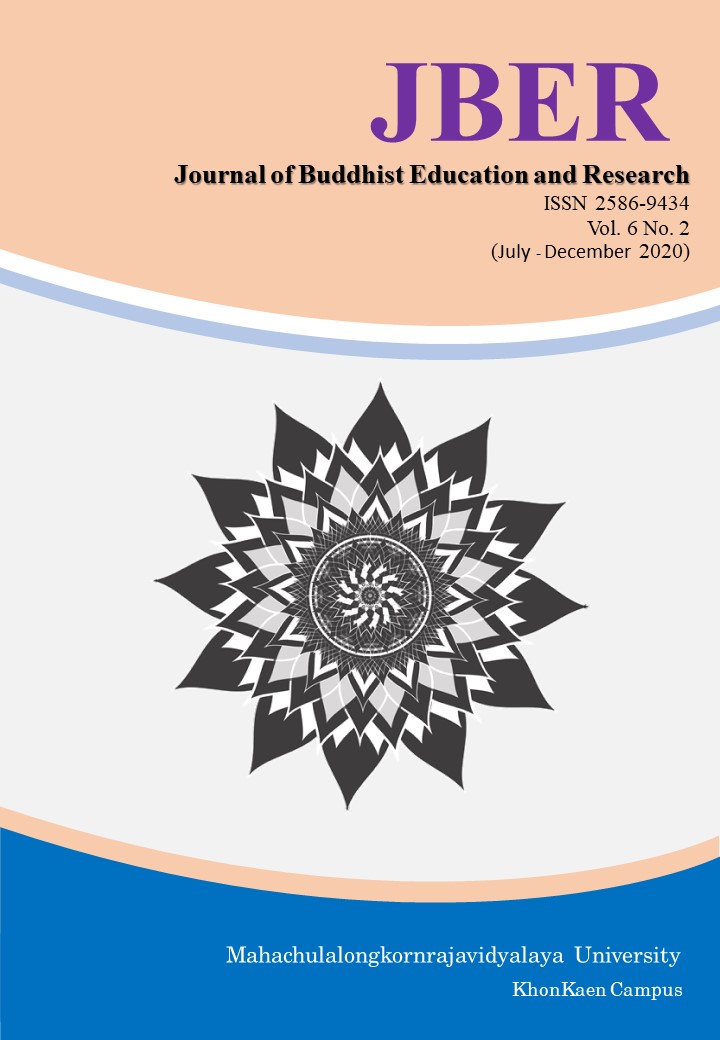SVABHĀVOKTI : THE DEPICTION OF NATURE IN THE MEGHADŪTA OF KĀLIDĀSA
Keywords:
meghadūta, magnificent (alaṅkāra), nature depiction , NirasAbstract
The objectives of this research were (1) to study the Alaṃkāra Svabhāvokti and other outstanding Alaṃkāra that appeared in “Meghadūta of Kālidāsa” The analyzing was based on the theory of Alāṃkāraśāstra (magnificent, glorious) showing the art created language, and (2) to study an influence of the Meghadūta affected to Thai literature, Thai Niras (poem).
The results of the study were found that; In the view point of magnificent values, Kālidāsa had created 2 splendors: (1) sound, and (2) meaning. The magnificence of sound in Meghadūta was found in the categories of Yamaka and Anuprāsa, consisting of chekānuprāsa, lāṭānuprāsa, vṛttyānuprāsa, śrutyānuprāsa, and antyānuprāsa. Whereas the magnificence of meaning was found that they are 2 main features: 1) Arthālaṅkāra is the describing of the glorious natures (Svabhāvokti) which is the most outstanding one including 5 features; (1) describing of plant species (2) describing of rivers and the mountains (3) describing of various animals (4) describing of cities and buildings, and (5) describing of individual human beings, and 2) Arthālaṅkāra is a comparison of natures and various things to express the appearances, including 11 features; (1) Upamā (2) Utprekṣā (3) Rūpaka (4) Vayatireka (5) Prativastūpamā (6) Ākṣepa (7) Samāsokti (8) Dīpaka (9) Nidraśana (10) Hetu, and (11) Ekāvalī.
From the study of Thai Niras literature, it reviewed that Meghadūta was influential in writhing Thai Niras literature. The content analysis was divided into 5 categories: 1) a depiction of mourning for love, 2) a depiction of social knowledge, 3) a depiction of the poet's point of view, 4) a descriptive and expressive message to the beloved lady, and 5) a depiction of the rotation of time.
References
จำลอง สารพัดนึก. (2546). ประวัติวรรณคดีสันสกฤต 1. กรุงเทพฯ: สำนักพิมพ์มหาวิทยาลัยรามคำแหง.
________. (2540). เมฆทูตของมหากวีกาลิทาส. (พิมพ์ครั้งที่ 1). กรุงเทพฯ: โรงพิมพ์มหาจุฬาลงกรณราชวิทยาลัย.
จิรพัฒน์ ประพันธ์วิทยา. ผู้แปล. (2523). เมฆทูตของกาลิทาส. ภาควิชาภาษาตะวันออก คณะโบราณคดี มหาวิทยาลัยศิลปากร.
มณีปิ่น พรหมสุทธิรักษ์. (2551). ประวัติวรรณคดีสันสกฤต. นครปฐม: ภาควิชาภาษาไทย คณะอักษรศาสตร์ มหาวิทยาลัยศิลปากร.
P.V. Kane. (1974). The Sāhityadarpaṇa of Viśvanātha. Delhi: Motilal Banarsidass.





